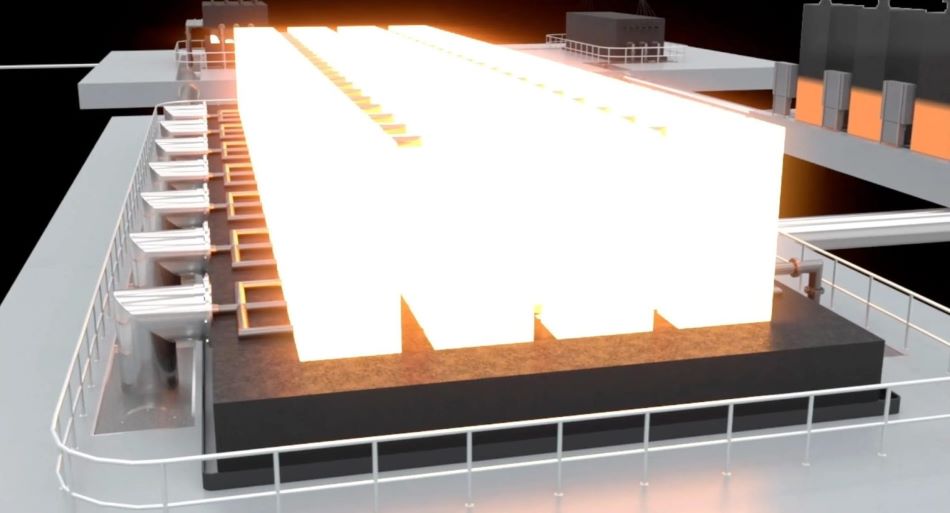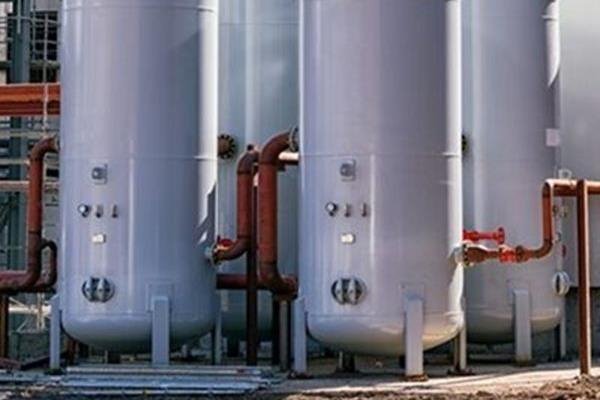Energy Blog: Heat Batteries Step into the Spotlight
Energy Blog: Heat Batteries Step into the Spotlight


Hot bricks won’t power a car, but in the world of grid-scale energy, thermal storage is getting its day in the sun.
When intermittent power sources such as wind and solar began contributing to the electric grid, they produced so little power that they could be seen as a “negative load,” basically shaving off demand rather than adding meaningful megawatt-hours. But the prospect that they could become a major power source set entrepreneurs looking at ways to store excess energy produced on sunny days or windy nights for use at a later time.
Today, wind and solar power have far exceeded the projections of twenty years ago. According to the U.S. Energy Information Administration, wind power accounted for 10.2 percent of electric generation in 2023, and solar power produced another 3.9 percent. But those national averages spread over the entire year hide extreme regional and temporal variations. In mid-March 2024, for instance, the California electric grid received so much wind and solar power in the middle of the day that often, no other power source was needed. But at night, the contribution of wind alone was negligible.
The potential to save electricity when it is generated in excess and use it when it is in shorter supply makes the development of grid-scale electricity storage more vitally important than ever.
 At the moment, the technology being deployed for grid-scale energy storage is the same one providing mobile power to cars and cell phones: Lithium-ion batteries. That makes economic sense, as the cost of lithium-ion batteries per kWh of storage has dropped by a factor of five since 2013, due in large part to the optimization of manufacturing them at a scale needed to put them in millions of electric vehicles and billions of mobile electronic devices. Many utilities looking to add reliable power have discovered that the cost of solar plus batteries is less expensive than building a new coal power plant—and in some cases, cheaper than keeping existing coal plants operating.
At the moment, the technology being deployed for grid-scale energy storage is the same one providing mobile power to cars and cell phones: Lithium-ion batteries. That makes economic sense, as the cost of lithium-ion batteries per kWh of storage has dropped by a factor of five since 2013, due in large part to the optimization of manufacturing them at a scale needed to put them in millions of electric vehicles and billions of mobile electronic devices. Many utilities looking to add reliable power have discovered that the cost of solar plus batteries is less expensive than building a new coal power plant—and in some cases, cheaper than keeping existing coal plants operating.
While it may seem that batteries have won the energy storage wars, many startups are contesting that victory. It’s true that lithium-ion batteries pack a lot of power into a small package, but that is less important for stationary facilities such as grid-scale electric storage than for cars or phones. Most lithium-ion batteries contain exotic materials that are subject to supply-chain disruptions. And the need to recycle these batteries after several years has not been factored into their cost.
Some companies have explored such simple ideas as raising and lowering concrete blocks or storing energy in a spinning flywheel, but today the technology with some of the greatest interest is thermal energy storage. This involves using excess electricity or waste heat to raise the temperature of a cheap bulk storage medium, and then tapping that heat to produce electricity when needed.
More on This Topic: Renewable-Heavy Grids Need Watts in Store
Storing heat to use for power is an old concept. In the late 1800s, so-called fireless locomotives would keep high-temperature water in a pressurized tank called a steam accumulator; when the pressure was relieved, the water boiled to produce steam to power the engine. A stationary steam accumulator built in Germany in the 1920s was large enough to drive a 50 MW steam turbine.
The storage medium of interest today is solid: firebricks, graphite, or even common gravel. The concept is to use resistive heating (essentially, overgrown toaster coils) to heat these solid blocks to more than 1,000 °C; with proper insulation, the blocks can maintain those high temperatures for hours or even days.
The simplest method for tapping that energy is to use it directly as process heat for industry. To convert the energy back into electricity, some companies are looking to run an inert gas through stacks of blocks to bring it to high temperatures and then using it to drive a high-efficiency gas turbine. For instance, Antora Energy, a startup in Sunnyvale, Calif., uses electric coils embedded in blocks of graphite to raise their temperature to 1,800 °C. That concept has the advantage of using conventional equipment that is already part of the backbone of the electric grid.
Become an ASME Member Today
One company, Cambridge, Mass., startup Fourth Power, is developing a system that stores energy in molten tin and graphite blocks at a very high temperature, around 2,800 °C, and relies on a type of photovoltaic cell tuned to infrared light. The concept has promise—in laboratory tests, thermophotovoltaic cells can convert as much as 40 percent of heat energy to electricity—but as yet remains unproven at utility scales.
Efficiency will be an ongoing problem for these systems. The roundtrip efficiency of a lithium-ion battery is greater than 80 percent, while heat storage systems are limited by thermodynamics to half that or less (sometimes much less). The developers of these systems contend that materials cost, durability, and ability to scale will enable thermal systems to compete with batteries.
It’s an argument that has earned some startups millions of dollars in investment. Now these companies need to prove that the best grid-scale battery is a simple stack of bricks.
Jeffrey Winters is editor in chief of Mechanical Engineering magazine.
Today, wind and solar power have far exceeded the projections of twenty years ago. According to the U.S. Energy Information Administration, wind power accounted for 10.2 percent of electric generation in 2023, and solar power produced another 3.9 percent. But those national averages spread over the entire year hide extreme regional and temporal variations. In mid-March 2024, for instance, the California electric grid received so much wind and solar power in the middle of the day that often, no other power source was needed. But at night, the contribution of wind alone was negligible.
The potential to save electricity when it is generated in excess and use it when it is in shorter supply makes the development of grid-scale electricity storage more vitally important than ever.

Design & Fabrication of Pressure Vessels
Learn the rules for pressure vessel design and construction, this course is a comprehensive introduction to the requirements of Section VIII, Division 1.
While it may seem that batteries have won the energy storage wars, many startups are contesting that victory. It’s true that lithium-ion batteries pack a lot of power into a small package, but that is less important for stationary facilities such as grid-scale electric storage than for cars or phones. Most lithium-ion batteries contain exotic materials that are subject to supply-chain disruptions. And the need to recycle these batteries after several years has not been factored into their cost.
Some companies have explored such simple ideas as raising and lowering concrete blocks or storing energy in a spinning flywheel, but today the technology with some of the greatest interest is thermal energy storage. This involves using excess electricity or waste heat to raise the temperature of a cheap bulk storage medium, and then tapping that heat to produce electricity when needed.
More on This Topic: Renewable-Heavy Grids Need Watts in Store
Storing heat to use for power is an old concept. In the late 1800s, so-called fireless locomotives would keep high-temperature water in a pressurized tank called a steam accumulator; when the pressure was relieved, the water boiled to produce steam to power the engine. A stationary steam accumulator built in Germany in the 1920s was large enough to drive a 50 MW steam turbine.
The storage medium of interest today is solid: firebricks, graphite, or even common gravel. The concept is to use resistive heating (essentially, overgrown toaster coils) to heat these solid blocks to more than 1,000 °C; with proper insulation, the blocks can maintain those high temperatures for hours or even days.
The simplest method for tapping that energy is to use it directly as process heat for industry. To convert the energy back into electricity, some companies are looking to run an inert gas through stacks of blocks to bring it to high temperatures and then using it to drive a high-efficiency gas turbine. For instance, Antora Energy, a startup in Sunnyvale, Calif., uses electric coils embedded in blocks of graphite to raise their temperature to 1,800 °C. That concept has the advantage of using conventional equipment that is already part of the backbone of the electric grid.
Become an ASME Member Today
One company, Cambridge, Mass., startup Fourth Power, is developing a system that stores energy in molten tin and graphite blocks at a very high temperature, around 2,800 °C, and relies on a type of photovoltaic cell tuned to infrared light. The concept has promise—in laboratory tests, thermophotovoltaic cells can convert as much as 40 percent of heat energy to electricity—but as yet remains unproven at utility scales.
Efficiency will be an ongoing problem for these systems. The roundtrip efficiency of a lithium-ion battery is greater than 80 percent, while heat storage systems are limited by thermodynamics to half that or less (sometimes much less). The developers of these systems contend that materials cost, durability, and ability to scale will enable thermal systems to compete with batteries.
It’s an argument that has earned some startups millions of dollars in investment. Now these companies need to prove that the best grid-scale battery is a simple stack of bricks.
Jeffrey Winters is editor in chief of Mechanical Engineering magazine.





